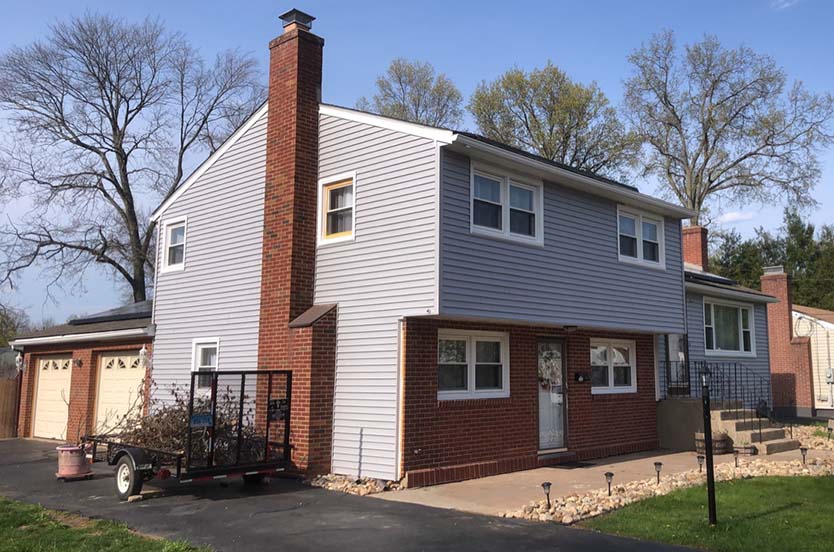
Painting a brick house is a bold move. It instantly changes the personality of your home and can take your curb appeal from dated to dynamic. But learning how to paint brick house correctly is essential if you want that transformation to last.
This isn’t like painting drywall or siding. Brick is porous. It breathes. And if you paint it without understanding the process, you can trap moisture, ruin the brick, and face serious maintenance issues down the line.
Let’s break down exactly how to paint brick house from prep to finish, and do it with the kind of confidence that gets results.
Know the Pros and Cons
Painting brick isn’t something you can undo. It’s permanent. So before diving into how to paint brick house, make sure it’s the right decision for your property.
Pros of Painting Brick
♦ Enhanced curb appeal: A fresh color modernizes your home instantly.
♦ Protection against the elements: Premium paint offers strong protection against moisture, UV rays, and mildew growth.
♦ Better resale value: Many buyers prefer painted brick over outdated red or orange tones.
♦ Custom style: You’re no longer stuck with the brick you were given.
Cons of Painting Brick
♦ Irreversible: Once it’s painted, you can’t go back to bare brick without extreme effort.
♦ Maintenance: You’ll need to repaint or touch up every 7–10 years.
♦ Risk of moisture issues: If you don’t use the right materials and techniques, water can get trapped inside.
♦ Labor-intensive prep: Brick needs to be properly cleaned, repaired, and primed.
The choice is yours. But if you’re ready to move forward, here’s how to paint brick house the right way, step by step.
Step 1: Preparation Is Everything
You wouldn’t build a house without a foundation. Painting brick without proper prep is no different.
Tools and Supplies Needed
♦ Pressure washer or stiff-bristle brush.
♦ Dish soap or masonry cleaner.
♦ Bleach solution for mold or mildew.
♦ Masonry repair caulk.
♦ Drop cloths and painter’s tape.
♦ Safety gear: gloves, goggles, mask.
Cleaning the Brick Surface
Before anything else, you need a clean surface. Dirty or moldy brick won’t hold paint well.
1. Pressure wash the entire exterior
Remove dirt, dust, mold, and mildew.
2. Use a bleach solution if needed
Mix 1 part bleach to 3 parts water. Scrub moldy areas and rinse thoroughly.
3. Let the brick dry completely
This could take 2–3 days. Don’t rush it. Wet brick equals paint failure.
Repairing Cracks and Gaps
Brick and mortar cracks must be sealed before painting.
♦ Fill holes and cracks with masonry caulk.
♦ Wait about 24 hours to let repairs fully set before you start painting.
♦ Double-check areas that may trap water and fix them before continuing.
If you’ve done this right, the surface will be clean, smooth, and completely dry. That’s when you’re ready to paint.
Step 2: Choosing the Right Products
Here’s where most homeowners make mistakes. If you don’t select the right paint and primer, even the best technique won’t save your finish.
Best Primer for Brick
♦ Masonry primer: Specifically made for brick and concrete. Helps paint adhere and blocks moisture.
♦ Stain-blocking primer: Great if your brick has soot, rust, or discoloration.
Make sure the primer is breathable. Trapping moisture inside your walls can cause major damage.
Best Paint for Brick Homes
♦ Acrylic latex paint: Its durability, breathability, and flexibility make it especially well-suited for protecting and preserving exterior brick.
♦ Elastomeric paint: Extremely thick and elastic, great for older or cracked surfaces.
♦ Mineral-based paint or limewash: Natural-looking and breathable, exactly what historic homes need.
Choosing a Finish
♦ Flat or matte: Traditional look, hides flaws.
♦ Satin: Slight sheen, easier to clean.
♦ Avoid gloss: Reflects too much and shows every imperfection.
When figuring out how to paint brick house, selecting the right materials is just as important as applying them correctly.
We’re Just a Call Away. Let’s Talk About Your Next Project
Step 3: The Painting Process
This is the part you’ve been waiting for. Let’s go through exactly how to paint brick house in the most efficient and effective way.
What You’ll Need
♦ Paint sprayer (optional but highly effective)
♦ 1” to 2” angled brush for edges and details
♦ Thick-nap roller (3/4″ or higher)
♦ Extension pole
♦ Ladder or scaffolding
How to Paint Brick House: The Exact Steps
1. Mask off surfaces
Tape around windows, doors, and trim. Use drop cloths on the ground.
2. Prime the brick
Use your roller or sprayer for broad areas. Use a brush for tight spots or mortar lines. Let it dry completely.
3.Cut in with your brush
Paint around edges and corners before rolling or spraying the larger areas.
4. Apply the first coat of paint
Use even strokes. Don’t overload the roller. Watch for drips in mortar joints.
5. Let it dry
Check the label, most paints need 4 to 6 hours to dry before you add another coat.
6. Apply the second coat
It goes on smooth and helps your paint job last longer.
7. Clean up and inspect
Remove tape carefully. Touch up any areas that look thin or uneven.
If you follow these steps, you’ve learned how to paint brick house with results that look professional and last for years.
Step 4: Maintenance and Long-Term Care
Painted brick isn’t set-and-forget. Staying ahead of routine maintenance is key to keeping your home looking its best.
Routine Maintenance Checklist
♦ Inspect the exterior once a year
Look for peeling, cracking, or moisture damage.
♦ Clean the surface annually
Use a garden hose or soft pressure wash. No harsh chemicals needed.
♦ Address chips quickly
Touch up any damaged spots before water gets in.
♦ Plan to repaint every 7–10 years
If you used top-quality paint and did the prep work, that’s how long it should last.
Knowing how to paint brick house includes understanding how to take care of it. Maintenance is easy when the initial job is done right.
Common Mistakes to Avoid
Even well-intentioned homeowners make missteps. Here are the most common mistakes people make when learning how to paint brick house.
1: Painting Damp Brick
Moisture is the enemy. Painting wet brick traps water, leading to mold, bubbling, and flaking paint.
2: Using the Wrong Paint
Interior paint won’t last outside. Masonry paint is designed to adhere to and protect brick and concrete surfaces. Use it for optimal results.
3: Skipping Primer
No matter how good your paint is, brick needs a primer to ensure adhesion and coverage.
4: Rushing the Process
Every step needs time, from cleaning to drying to curing. Don’t cut corners.
5: Poor Surface Prep
If you paint over dirt or mildew, it will come back through. Prep work is 70% of the job.
Avoiding these pitfalls is just as important as knowing how to paint brick house properly. It’s what separates average jobs from excellent ones.
Conclusion
By now, you understand that learning how to paint brick house isn’t just a simple project, it’s a smart investment. Done wrong, it can lead to headaches. Done right, it elevates your home’s look, adds real value, and protects your property for years.
What makes the difference? Discipline. Attention to detail. The right tools. And most importantly, knowing what you’re doing before you do it.
If you want your house to stand out, if you’re ready for that transformation, and if you’re serious about doing it right the first time, then follow the steps in this guide and commit to excellence.




